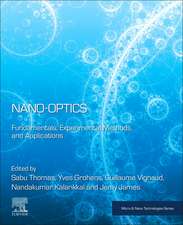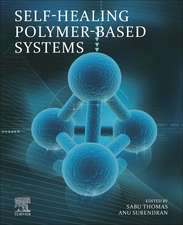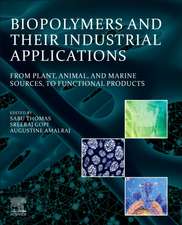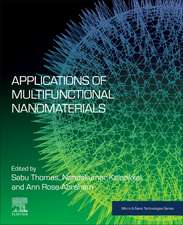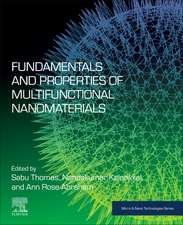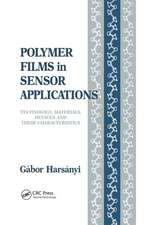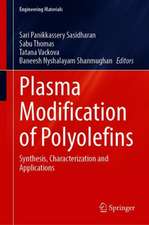Polymer Blend Nanocomposites for Energy Storage Applications: Micro and Nano Technologies
Editat de Sabu Thomas, Ajitha A. R, Maciej Jaroszewskien Limba Engleză Paperback – 28 iun 2023
Devices discussed include capacitors, supercapacitors, batteries, fuel cells, and solar cells. Finally, other key aspects are considered, including the conversion from laboratory to industry and recycling and lifecycle assessment of polymer blend nanocomposites used in energy devices.
- Focuses on nanocomposites based on polymer blends, both conducting and nonconducting
- Guides the reader to applications in capacitors, supercapacitors, batteries, fuel cells, and solar cells, among others
- Considers translation from lab to industry, recycling, and lifecycle assessment
Din seria Micro and Nano Technologies
- 20%
 Preț: 768.40 lei
Preț: 768.40 lei - 18%
 Preț: 2031.79 lei
Preț: 2031.79 lei - 9%
 Preț: 1043.14 lei
Preț: 1043.14 lei - 9%
 Preț: 987.08 lei
Preț: 987.08 lei -
 Preț: 550.23 lei
Preț: 550.23 lei - 24%
 Preț: 1048.26 lei
Preț: 1048.26 lei - 23%
 Preț: 1100.40 lei
Preț: 1100.40 lei - 28%
 Preț: 738.06 lei
Preț: 738.06 lei - 23%
 Preț: 692.90 lei
Preț: 692.90 lei - 28%
 Preț: 571.91 lei
Preț: 571.91 lei - 9%
 Preț: 733.82 lei
Preț: 733.82 lei - 23%
 Preț: 734.77 lei
Preț: 734.77 lei - 28%
 Preț: 811.47 lei
Preț: 811.47 lei - 16%
 Preț: 766.36 lei
Preț: 766.36 lei - 28%
 Preț: 934.58 lei
Preț: 934.58 lei - 32%
 Preț: 528.10 lei
Preț: 528.10 lei - 23%
 Preț: 810.11 lei
Preț: 810.11 lei - 23%
 Preț: 603.19 lei
Preț: 603.19 lei - 9%
 Preț: 571.98 lei
Preț: 571.98 lei - 28%
 Preț: 825.39 lei
Preț: 825.39 lei -
 Preț: 222.86 lei
Preț: 222.86 lei - 16%
 Preț: 290.93 lei
Preț: 290.93 lei - 19%
 Preț: 659.03 lei
Preț: 659.03 lei - 18%
 Preț: 653.54 lei
Preț: 653.54 lei - 23%
 Preț: 746.61 lei
Preț: 746.61 lei - 9%
 Preț: 1016.51 lei
Preț: 1016.51 lei - 9%
 Preț: 736.59 lei
Preț: 736.59 lei - 29%
 Preț: 803.90 lei
Preț: 803.90 lei - 9%
 Preț: 963.06 lei
Preț: 963.06 lei - 28%
 Preț: 644.55 lei
Preț: 644.55 lei - 23%
 Preț: 813.30 lei
Preț: 813.30 lei - 23%
 Preț: 608.83 lei
Preț: 608.83 lei - 9%
 Preț: 683.99 lei
Preț: 683.99 lei - 9%
 Preț: 792.39 lei
Preț: 792.39 lei - 23%
 Preț: 732.00 lei
Preț: 732.00 lei - 23%
 Preț: 909.30 lei
Preț: 909.30 lei - 28%
 Preț: 698.33 lei
Preț: 698.33 lei - 29%
 Preț: 989.78 lei
Preț: 989.78 lei - 28%
 Preț: 737.80 lei
Preț: 737.80 lei - 9%
 Preț: 848.26 lei
Preț: 848.26 lei - 23%
 Preț: 937.71 lei
Preț: 937.71 lei - 23%
 Preț: 692.32 lei
Preț: 692.32 lei - 24%
 Preț: 869.31 lei
Preț: 869.31 lei - 23%
 Preț: 609.24 lei
Preț: 609.24 lei - 18%
 Preț: 222.37 lei
Preț: 222.37 lei - 28%
 Preț: 816.40 lei
Preț: 816.40 lei - 9%
 Preț: 811.32 lei
Preț: 811.32 lei - 21%
 Preț: 292.28 lei
Preț: 292.28 lei - 9%
 Preț: 807.78 lei
Preț: 807.78 lei - 5%
 Preț: 637.68 lei
Preț: 637.68 lei
Preț: 1165.34 lei
Preț vechi: 1524.32 lei
-24% Nou
Puncte Express: 1748
Preț estimativ în valută:
222.98€ • 233.44$ • 184.51£
222.98€ • 233.44$ • 184.51£
Carte tipărită la comandă
Livrare economică 29 martie-12 aprilie
Preluare comenzi: 021 569.72.76
Specificații
ISBN-13: 9780323995498
ISBN-10: 0323995497
Pagini: 570
Dimensiuni: 191 x 235 mm
Editura: ELSEVIER SCIENCE
Seria Micro and Nano Technologies
ISBN-10: 0323995497
Pagini: 570
Dimensiuni: 191 x 235 mm
Editura: ELSEVIER SCIENCE
Seria Micro and Nano Technologies
Public țintă
Academia: Researchers and advanced students across nanotechnology, polymer science, composite science, surface science, chemistry, and materials science.Industry: Scientists, engineers, and R&D professionals with an interest in polymer nanocomposites for energy storage applications.
Cuprins
Section 1 Introduction Chapter 1 Polymer blend nanocomposites: Fundamentals, preparation, and characterization Chapter 2 Fundamental mechanisms and requirements of energy storage materials Section 2 Types of polymer blend nanocomposites in applications for energy storage Chapter 3 Elastomeric polymer blend nanocomposites for energy storage applications Chapter 4 Thermoplastic-based polymer blend nanocomposites for energy storage Chapter 5 Thermosetting-based blend polymer nanocomposites for energy storage Chapter 6 Biodegradable polymer blend nanocomposites for energy storage application Chapter 7 Polymer blend nanocomposite electrolytes for advanced energy storage applications Section 3 Polymer blend nanocomposites with various fillers for energy storage applications Chapter 8 Polymer blend nanocomposites with CNTs for energy storage applications Chapter 9 Graphene-based polymer blend nanocomposites for energy storage applications Chapter 10 Polymer blend nanocomposites of fullerene for energy storage Chapter 11 Polymers with carbon-based quantum dots for energy storage Chapter 12 Polymer blend nanocomposites with metal-based nanomaterials for energy storage Chapter 13 Polymer blend nanocomposites with hybrid nanomaterials for energy storage Section 4 Applications of polymer blend nanocomposites in energy devices Chapter 14 Polymer blend nanocomposites for capacitor applications Chapter 15 Polymer blend nanocomposites for supercapacitor applications Chapter 16 Polymer blend nanocomposites for battery applications Chapter 17 Polymer blend nanocomposites for polymer electrolyte membrane fuel cell (PEMFC) applications Chapter 18 Polymer blend nanocomposites for solar cell applications Section 5 Lab to industry, recycling, and life cycle assessment Chapter 19 Polymer composites for energy storage: Commercialization, lifecycle assessment, and recycling


